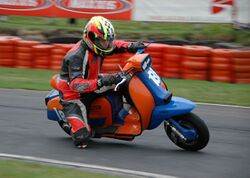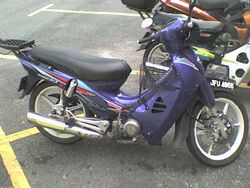Types of motorcycles
Topic: Engineering
 From HandWiki - Reading time: 14 min
From HandWiki - Reading time: 14 min
The six main types of motorcycles are generally recognized as standard, cruiser, touring, sports, off-road, and dual-purpose.[1][2][3][4] Sport touring is sometimes recognized as a seventh category or integrated with the touring category.[5][6]
Although there are many names and systems for classifying types of motorcycles based on their characteristics and usage, there are generally six categories recognized by most motorcycle manufacturers and organizations.[5]
Strong distinctions are usually made between the six main types of motorcycles and other motorcycles.[7] Scooter, moped, underbone, miniature, pocket, electric, and three-wheeled motorcycles are generally excluded from the main categories but other classification schemes may include these as types of motorcycles.[8]
There is no universal system for classifying all types of motorcycles. There are strict classification systems enforced by competitive motorcycle sport sanctioning bodies, or legal definitions of a motorcycle established by certain legal jurisdictions for motorcycle registration, emissions, road traffic safety rules or motorcyclist licensing. There are also informal classifications or nicknames used by manufacturers, riders, and the motorcycling media. Some experts do not recognize sub-types, like naked bike, that "purport to be classified" outside the six usual classes, because they fit within one of the main types and are recognizable only by cosmetic changes.[9]
Street motorcycles are motorcycles designed for being ridden on paved roads. They have smooth tires with tread patterns and engines generally in the 125 cc (7.6 cu in) and over range. Typically, street motorcycles are capable of speeds up to 100 mph (160 km/h), and many of speeds in excess of 125 mph (201 km/h). Street motorcycles powered by electric motors are becoming more common, with firms like Harley-Davidson entering the market.
Standard

Standard motorcycles (also called naked bikes, roadsters, or simply standards) are motorcycles mainly intended for use on streets for commuting.[5] They are characterized primarily by their upright riding position (in-between the reclining rider posture of the cruisers and the forward leaning of sport bikes) and most of the usable torque (powerband) at lower engine rpm for commuting and fuel efficiency.[2]
Standards are typically not equipped with fairings or windscreens from the manufacturer, hence the name naked bikes.[5] Standard is often a synonym for naked, a term that was originally used in reference to 1950s road racing bikes.[10][11] Footpegs are below the rider and handlebars are high enough to not force the rider to reach too far forward, placing the shoulders above the hips in a natural position.[1] [5][2][3][7] Due to their flexibility, lower costs, moderate engine output, and up-right seating position, standards are particularly suited for beginner motorcyclists.[5]
Cruiser
Cruiser motorcycles (or simply cruisers) are styled after American motorcycles from the 1930s to the early 1960s, such as those made by Harley-Davidson, Indian, and Excelsior-Henderson.[5] Harley-Davidsons largely define the cruiser category, and large-displacement V-twin engines are the norm, although other engine configurations and small to medium displacements also exist.[5] Their engines are tuned for low-end torque, making them less demanding to ride because it is not necessary to shift as frequently to accelerate or maintain control.[12]
The riding position places the feet forward and the hands are up relatively high, so that the spine is erect or leaning back slightly.[5][2] At low to moderate speeds, cruisers are more comfortable than other styles,[2][3] but riding for long periods at freeway speeds can lead to fatigue from pulling back on the handlebars to resist the force of the wind against the rider's chest.[13] Cruisers have limited cornering ability due to a lack of ground clearance.[2][12]
Choppers are a type of cruiser, so called because they are a "chopped", or cut-down, version of a production cruiser. Choppers are usually custom projects that result in a bike modified to suit the owner's ideals, and, as such, are a source of pride and accomplishment. Stereotypically, a chopper may have raked-out forks, small fuel tanks and high handlebars. Choppers were popularised in the Peter Fonda film Easy Rider. Being designed primarily for visual effect, choppers will not usually be the most efficient riding machines.
Related to the chopper motorcycle is the bobber which is created by "bobbing" a factory bike by removing dead weight and bodywork from a motorcycle to reduce mass and increase performance. A common element of these motorcycles is a shortened rear fender that creates a "bobbed" look.
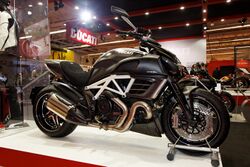
Power cruiser is a name used to distinguish bikes in the cruiser class that have significantly higher levels of power. They often come with upgraded brakes and suspensions, better ground clearance, and premium surface finishes, as well as more exotic or non-traditional styling.[14][15][16][17][18][19][12]
Touring
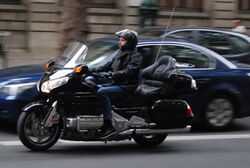
Although any motorcycle can be equipped and used for touring, touring motorcycles are specifically designed to excel at covering long distances.[5] They have large-displacement engines, fairings and screens that offer good weather and wind protection, large-capacity fuel tanks for long ranges between fill-ups, and a relaxed, upright seating position.[5] Passenger accommodation is excellent and expansive luggage space is the norm for this class.[5] Such bikes can have wet weights of 850–900 lb (390–410 kg) and top 1,300–1,400 lb (590–640 kg) fully loaded with a rider, passenger and gear.[12]
Bagger, full dresser, full dress tourer, or dresser are various names for touring motorcycles, sometimes used disparagingly or jocularly, and originally referring to a Harley-Davidson or other cruisers with full sets of saddlebags. This can now refer to any touring motorcycle.[12][20][21][22]
Sport
Sport bikes are road bikes that emphasize top speed, acceleration, braking, handling and grip,[2][4][23][24] typically at the expense of comfort and fuel economy in comparison to other motorcycle types.[5][7] Sport bikes have comparatively high performance engines supported within a lightweight frame. Inline-four engines dominate the sport bike category, with V-twins and parallel twins having a significant presence; and most other engine configurations appear in small numbers at times.[5] High-performance braking systems may use upgraded brake pads, multi-piston calipers and larger vented rotors.[5] Sports bike suspension systems may be more sophisticated, with greater adjustments for compression and rebound.[5] Sport bikes have fairings to completely enclose the engine, along with windscreens that effectively deflect the air at high speeds away from the rider, thereby minimising overall drag.[5]
Sport bikes may have footpegs that are both higher and set further back than on a standard bike, improving ground clearance when cornering and enabling a more prone position for the rider. There may be a long reach to the hand controls, which positions the body and center of gravity forward, above the fuel tank. The rider leans forward into the wind, the force of which may support the rider's weight at high speeds. However, at lower speeds a rider may experience excessive weight on the arms and wrists, causing fatigue.
Muscle bike is a nickname for a motorcycle type, derived from a sport bike design, that puts a disproportionately high priority on engine power.[5][25][26][27]
Streetfighters are derived from sport bikes, originally being customized sport bikes with the fairings removed and higher handlebars replacing the low clip-on handlebars.[28][29] Since the 1990s, factory streetfighters have been produced.[30] As with naked bike and muscle bike (below), the name streetfighter is used to help clarify the middle ground occupied by designs that blend elements of both sport bikes and standards.[31]
Off-road
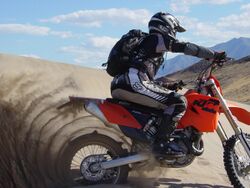
Off-road motorcycles, also known as dirt bikes or scramblers, specially designed for off-road use. The term off-road refers to driving surfaces that are not conventionally paved. These are rough surfaces, often created naturally, such as sand, gravel, a river, mud or snow. These types of terrain can sometimes only be travelled on with vehicles designed for off-road driving (such as SUVs, ATVs, snowmobiles and mountain bikes in recent decades, and minibikes even earlier) or vehicles are designed to better handle off-road conditions. Compared to road-going motorcycles, off-road machines are lighter and more flexible, typically having long suspension travel, high ground clearance, and are geared higher to provide more torque in off-road situations.[32] Wheels (usually 21" front, 18" rear)[citation needed] have knobby tires, often clamped to the rim with a rim lock.[5]
Many competitive events have emerged[when?] and developed into a variety of off-road motorcycle sports, for which a number of specialized motorcycles have been built:
- Motocross—Such bikes are raced on short, closed off-road tracks with a variety of obstacles. The motorcycles have a small fuel tank for lightness and compactness. Long-travel suspension allows riders to take jumps at high speed. Motocross engines are single-cylinder two-stroke or four-stroke units, which vary in size from 50cc up to about 500cc. At the professional level, bikes are split up into two levels based on their displacements: MX and MX Lite. The MX Lite class contains 125cc two-stroke engines and 250cc four-stroke engines, while the MX class pits 250cc two-stroke engines against 450cc four-stroke engines. The actual displacement for both four-strokes and two-strokes can be under what is listed for the different bikes. The differences in power, displacement, torque, and weight are all variables that balance the competition between two-stroke and four-stroke engines.[33] Motocross sidecar outfits have bigger engines, usually four-stroke and often twin-cylinder. Motocross bikes are also used in freestyle motocross.
- Trials—Trials riding is a specialized form of off-road competition testing balancing skills and precision rather than speed. For a trials bike, low weight and crisp throttle response power are prioritized, so trials bikes tend to have a small (125 cc to 300 cc) engine, with two-strokes being common. During the trial, the rider stands on the foot-pegs, so a trials bike will have only a vestigial seat, or no seat at all.[34] Fuel tanks are very small, giving a very limited range. Trial usually consider the best for start riding off-road because of its low sit and light weight. Trial motorcycles are design to pass the tracks which is impossible for another kind of motorcycles to pass.
- Enduro—A modified and road-legal motocross bike which is something between a Trial motorcycle and Motocross, having the addition of a horn, lights, effective silencing and a number plate. Enduro riders compete over a longer course (which may include roads); and an enduro event may last between one day and six days (such as the International Six Days Enduro). Some enduro events (known as "multi-lappers") are held on rather shorter circuits, not unlike scramble tracks. "Multi-lappers" are especially popular with novice riders.
- Rally raid, or "rallies"—A special type of enduro bike with a significantly larger fuel tank for very long distance racing, typically through deserts (e.g. Paris-Dakar rally). Engine capacities tend to be larger, usually between 450 cc and 750 cc.
- Dual-Sport—A dual-sport bike is a multi-purpose bike, made for on-road and recreational off-road riding. A dual-sport bike may resemble an enduro bike, but since a dual-sport bike is not intended to be used for competition, it may be less rugged, and equipped with dual-purpose tires and with more road legal equipment, such as indicators, mirrors and extra instruments. Most dual-sport bikes require a number plate to be ridden on state and county roads.
- Track racing—High-speed oval racing, typically with no brakes, nor rear suspension. The engines, fueled by methanol, are long-stroke four-stroke singles, such as JAP and Jawa. They have at most two gears. Some types, such as speedway, and grass-track bikes, are designed to take left turns only.
- Snow bikes—A snow bike takes a typical dirt-bike and replaces the rear wheel with a single tread system similar to a snowmobile and the front wheel with a large ski. They are much smaller and more nimble than a snowmobile, and they have a tighter turning radius, which lets the rider go where many snowmobiles cannot. The first prototype of motorcycles with a rear tread date all the way back to the 1920s, with failed attempts to bring them onto the market until recent times. Many motorcycles made after the 1990s or later can be fitted with a kit that transforms them into a snow bike.[35]
Dual-purpose

Dual-purpose motorcycles, sometimes called dual-sport, on/off-road motorcycles, or adventure motorcycles, are street legal machines that are also designed to enter off-road situations.[5] Typically based on a dirt bike chassis, they have added lights, mirrors, signals, and instruments that allow them to be licensed for public roads.[2] They are higher than other street bikes, with a high center of gravity and tall seat height, allowing good suspension travel for rough ground.[5]
Adventure motorcycles (ADV) are motorcycles with touring capability on paved and unpaved roads. As a dual-sport they have a significant on-pavement bias and perform well on pavement at higher speeds unlike most dual-sports.[2][36] Their size, weight and sometimes their tires, however, limits their off-road capability. Most adventure motorcycles function well on graded dirt and gravel roads but are less than ideal on more difficult off-pavement terrain.
Supermoto motorcycles were designed to compete on a single course that alternated between three genres of motorcycle racing: road racing, track racing, and motocross. This increasingly popular type of motorcycle is often a dual-sport that has been fitted by the manufacturer with smaller rims and road tires. Supermotos are quickly gaining popularity as street bikes due to their combination of light weight, durability, relatively low cost, and sporty handling.
Sport touring

Sport touring motorcycles combine attributes of sport bikes and touring motorcycles. The rider posture is less extreme than a sport bike, giving greater long-distance comfort.[5] Accommodation for a passenger is superior to a sport bike as well, along with increased luggage capacity.[5] Being lighter, at 550–720 lb (250–330 kg) wet,[12] than a pure touring bike and often having racier engines, suspensions, and brakes, sport tourers corner better and are more at home being aggressively ridden on curvy canyon roads.[5] The distinction between touring and sport touring is not always clear as some manufacturers will list the same bike in either category in different markets. The Honda ST1300 Pan-European, for example, was listed by Honda as a sport touring motorcycle in the United States and Australia, but as a touring motorcycle in Europe.
Scooters, underbones and mopeds
Motor scooters are in many cases classified as a separate vehicle to motorbikes, given their large amount of differences, and different evolution.[37] Scooter engine sizes range smaller than motorcycles, 50–850 cc (3.1–51.9 cu in), and have all-enclosing bodywork that makes them cleaner and quieter than motorcycles, as well as having more built-in storage space.[12] Modern scooters have automatic clutches and continuously variable transmissions (CVT), which makes them easier to learn on and to ride.[12] Scooters usually have smaller wheels than motorcycles. They usually have the engine as part of the swingarm, so that their engines travel up and down with the suspension.
Underbones are small-displacement motorcycles with a step-through frame, descendants of the original Honda Super Cub. They are differentiated from scooters by their larger wheels and their use of footpegs instead of a floorboard. They often have a gear shifter with an automatic clutch.
The moped used to be a hybrid of the bicycle and the motorcycle, equipped with a small engine (usually a small two-stroke engine up to 50 cc, but occasionally an electric motor) and a bicycle drivetrain, and motive power can be supplied by the engine, the rider, or both. There are also Sport mopeds – a type of moped that resembles a sport bike.
In many places, mopeds are subject to less stringent licensing than bikes with larger engines and are popular as very cheap motorbikes, with the pedals seeing next to no use. Mopeds were very popular in the United States during the fuel-crisis of the late 1970s and early 1980s, but their popularity has fallen off sharply since the mid-1980s. In response to rising fuel prices in the first decade of the 2000s, U.S. scooter and moped ridership saw a resurgence.[12] Sales of motorcycles and scooters declined 43.2% in 2009, and continued to decrease in the first quarter of 2010, with scooter sales doing worst, down 13.3% compared to a 4.6% drop for all two-wheelers.[38]
Other types of small motorcycles include the minibike, monkey bike, Welbike, pocketbike, and pit bike.
Enclosed and feet forwards
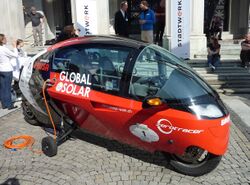
Enclosed motorcycles include cabin motorcycles and streamliner motorcycles.
Feet forwards motorcycles include the 1911 Wilkinson TMC and the 1918 Ner-A-Car. Contemporary examples include the Quasar, powered by a Reliant Robin engine, and the Peraves range powered mainly by BMW K Series engines.
Utility

Some motorcycles are specially adapted for specific job functions, such as those used by the ambulance, blood bikes, fire, and military services, and for specialized delivery services, such as pizza deliveries. Beginning in the 1960s with the Mountain Goat specialized motorcycles were developed for use on farms. The Motocrotte (or cainette) was used in Paris to collect dog waste with vacuum suction in the 1980s and 1990s, and was still in use in other French cities as of 2016.[39][40]
A derny is a motorized bicycle used for motor-paced cycling events.
Tricycles
While motorcycles typically have two wheels, some motorized tricycles are classed as three-wheeled motorcycles. Some brands have made various types of three-wheelers direct from the factory. Most of these vehicles are treated as motorcycles for registration or licensing purposes.
Tilting three-wheelers keep all three wheels on the ground when they lean to negotiate curves. These include Honda's Gyro range, all of which have a front wheel that leans and a pair of rear wheels that do not, and the Piaggio MP3, which has two front wheels and a single rear wheel, all of which lean. The Yamaha Niken is also a tilting three wheeler but has smaller track width such that it is considered a motorcycle by some authorities.
See also
- Motorcycling
- Outline of motorcycles and motorcycling
- List of motorcycle manufacturers
- List of scooter manufacturers
- List of motorized trikes
Notes
- ↑ 1.0 1.1 Kresnak, Bill (2008), Motorcycling for Dummies, Hoboken, New Jersey: For Dummies, Wiley Publishing, pp. 63–64, 66–70, 132–141, ISBN 978-0-470-24587-3, https://books.google.com/books?id=ZPgrJByqp4wC
- ↑ 2.0 2.1 2.2 2.3 2.4 2.5 2.6 2.7 2.8 Domino, Kevin (2009), The Perfect Motorcycle: How to Choose, Find and Buy the Perfect New Or Used Bike, 671 Press, pp. 47–58, ISBN 978-0-9821733-3-6
- ↑ 3.0 3.1 3.2 Holmstrom, Darwin (2001), The Complete Idiot's Guide to Motorcycles (2nd ed.), Alpha Books, pp. 20–21, 33–41, 334–358, 407, ISBN 0-02-864258-9, https://books.google.com/books?id=p9EyBoTaKy0C
- ↑ 4.0 4.1 McCraw, Jim (July 2005), "About That Bike…", Popular Mechanics (Hearst Magazines) 182 (7): 68–70, ISSN 0032-4558, https://books.google.com/books?id=ZNEDAAAAMBAJ&pg=PA68, retrieved 2010-06-04
- ↑ 5.00 5.01 5.02 5.03 5.04 5.05 5.06 5.07 5.08 5.09 5.10 5.11 5.12 5.13 5.14 5.15 5.16 5.17 5.18 5.19 5.20 5.21 5.22 5.23 Maher, Kevin; Greisler, Ben (1998), Chilton's Motorcycle Handbook, Haynes North America, pp. 2.2–2.18, ISBN 0-8019-9099-8, https://archive.org/details/chiltonsmotorcyc00grei/page/2
- ↑ "Sports [sic] Tourers". Suzuki GSX1100F, Honda CBR1000F, Yamaha GTS1000. Motorcycle Sport, June 1995, pp.284-288. Accessed 28 May 2022
- ↑ 7.0 7.1 7.2 Bennett, Jim (1995), The Complete Motorcycle Book: A Consumer's Guide, Facts on File, pp. 15–16, 19–25, ISBN 0-8160-2899-0, https://archive.org/details/completemotorcyc00benn/page/15
- ↑ The MAIDS report, using the OECD Road Transport Research Programme methodology, uses the following nine classifications for motorcycles, mopeds, and scooters, providing one illustration of each:
- Conventional street example: Triumph Bonneville T100
- Sport example: Triumph Daytona 955i
- Cruiser example: Suzuki Marauder
- Chopper example: a Harley-Davidson chopper in David Mann red
- Touring example: Honda Gold Wing GL1800
- Scooter example: Vespa Granturismo 200
- Step-through example: a moped
- Sport Touring example: Ducati ST4s
- Enduro example: KTM 950 Adventure S
- International Coordinating Committee of the Expert Group for Motorcycle Accident Investigations (2001), Motorcycles: Common International Methodology for On-Scene, In-Depth Accident Investigation, Paris: Road Transport Research Programme; of the Directorate for Science Technology and Industry; of the Organization for Economic Cooperation and Development, OECD/DSTI/RTR/RS9/ICC
- MAIDS (Motorcycle Accidents In Depth Study) Final Report 2.0, ACEM, the European Association of Motorcycle Manufacturers, April 2009, pp. 15–20, http://www.maids-study.eu/
- ↑ Broughton, Paul; Walker, Linda (May 6, 2009), Motorcycling and Leisure; Understanding the Recreational PTW Rider, Ashgate Publishing, Ltd., p. 7, ISBN 9780754675013, https://books.google.com/books?id=hp2kMO8YYKEC&pg=PA7, retrieved September 14, 2013
- ↑ TT '78 A Motor Cycle News special, EMAP publication, 1978. Hailwood's homecoming, pp.57-61. Accessed June 18 2018
- ↑ Motorcyclist Illustrated, October 1974, p.13, Bomber, Norton Commando John Player Special road test by Dave Minton (pp.10-15). Accessed September 20 2021
- ↑ 12.0 12.1 12.2 12.3 12.4 12.5 12.6 12.7 12.8 Stermer, Bill (2006), Streetbikes: Everything You Need to Know, Saint Paul, Minnesota: Motorbooks Workshop/MBI, pp. 8–17, ISBN 0-7603-2362-3, https://archive.org/details/streetbikesevery0000ster/page/8
- ↑ Ash, Kevin (1 May 2011), "Ducati Diavel UK road test", Ash on Bikes, http://www.ashonbikes.com/content/ducati-diavel-uk-road-test-0, retrieved 2011-05-01
- ↑ 2015 EICMA: Ducati reveals XDiavel power cruiser motorcycle
- ↑ FIRST LOOK: 2016 DUCATI XDIAVEL FROM EICMA 2015 | MOTORCYCLIST
- ↑ "Yamaha V Max - Motorcycle.com". http://www.motorcycle.com/manufacturer/yamaha-v-max.html.
- ↑ 2009 Yamaha/Star Vmax Road Test | Rider Magazine | Rider Magazine
- ↑ 2015 Ducati Diavel First Ride - Motorcycle USA
- ↑ COMPARISON TEST: Ducati Diavel Carbon vs. Honda Gold Wing Valkyrie vs. Star VMAX
- ↑ Kelly, Howard, Custom Motorcycles: Choppers, Bobbers, Baggers, p. 161, ISBN 9781616730994, https://books.google.com/books?id=lk5FJlRFOA8C&pg=PA161
- ↑ Duglin Kennedy, Shirley (2005), The Savvy Guide to Motorcycles, Indy Tech Publishing, p. 232, ISBN 978-0-7906-1316-1, https://books.google.com/books?id=kEX7Ncd3hO4C&pg=PA232
- ↑ Joans, Barbara (2001), Bike lust: Harleys, women, and American society, Univ of Wisconsin Press, p. 259, ISBN 9780299173548, https://books.google.com/books?id=0VEvUavtKMcC&pg=PA259
- ↑ Hough, David L. (2003), More Proficient Motorcycling: The Ultimate Guide to Riding Well (2nd ed.), USA: BowTie Press, p. 253, ISBN 1-931993-03-3, https://books.google.com/books?id=Z51FAQAACAAJ, "sportbike: a motorcycle designed for aggressive performance, especially cornering"
- ↑ sport bike (3rd ed.), Oxford University Press, September 2005, http://oed.com/search?searchType=dictionary&q=sport+bike (Subscription or UK public library membership required.) ("…a powerful, lightweight motorcycle, designed for optimal speed and handling" )
- ↑ Stermer, Bill (December 2002), "The Next Wave; The future of motorcycling is on display at Germany's Itermot Show", American Motorcyclist (American Motorcyclist Association): 32–35, 55, https://books.google.com/books?id=8foDAAAAMBAJ&pg=PA34, retrieved 2010-06-04
- ↑ "Monster Ducati", American Motorcyclist (American Motorcyclist Association): 29, February 1993, https://books.google.com/books?id=NfcDAAAAMBAJ&pg=PA26, retrieved 2010-06-04
- ↑ Henshaw, Peter (2012), How Your Motorcycle Works: Your Guide to the Components & Systems of Modern Motorcycles, Veloce Publishing, p. 8, ISBN 9781845844943, https://books.google.com/books?id=3SPdhUYsec0C&pg=PA8, retrieved July 23, 2014
- ↑ Wallis, Michael; Clark, Marian (2004), Hogs on 66: Best Feed and Hangouts for Road Trips on Route 66, Council Oak Books, ISBN 9781571781406, https://books.google.com/books?id=4b_qJyw-ZX8C, "Streetfighter -- Also known as a 'hooligan' cycle, this is a sports-bike stripped of all superfluous bodywork."
- ↑ Doeden, Matt; Leonard, Joe (2007), Choppers, Lerner Publications, ISBN 9780822572886, https://books.google.com/books?id=7wDcbl-UsmYC&pg=PA46, "streetfighter: a type of superbike customized for maximum speed and performance."
- ↑ Inman, Gary (June 2008), "Freedom Fighter; Triumph's stripped-down sportbike came from the street", Cycle World: 36–7, ISSN 0011-4286
- ↑ Fraser, Colin (May 12, 2000), "It may be naked and a street fighter, but don't call Buell a UJM", National Post (Don Mills, Ontario): F.4
- ↑ Clymer, admin (May 10, 2017). "Street Bike vs Dirt Bike - What's the Difference?". http://blog.clymer.com/road-bike-vs-dirt-bike-whats-the-difference/.
- ↑ Steinke, Gared (June 29, 2016). "MXA's Two-Stroke Tuesday: The AMA Displacement Rule". https://motocrossactionmag.com/mxas-two-stroke-tuesday-the-ama-displacement-rule/.
- ↑ What is MotoTrials, AMA/NATC USA National Championship MotoTrials Series, 2013, http://www.mototrials.com/13-about/what-is-trials
- ↑ Rose, Brent (November 29, 2017). "What Are Snow Bikes and How Are They So Awesome?". https://www.popularmechanics.com/adventure/outdoors/a13974686/the-snow-bikes-are-coming/.
- ↑ Duke, Kevin (January 15, 2006), "2006 Adventure Touring Comparo", MotorcycleUSA, http://www.motorcycle-usa.com/2006/01/article/2006-adventure-touring-comparo/, retrieved 2011-11-19
- ↑ Michael A. Regan, Gavan Lintern, Robin Hutchinson, Christine Turetschek, "Use of Cognitive Work Analysis for exploration of safety management in the operation of motorcycles and scooters" Volume 74, 2015, pp. 279-289
- ↑ Carpenter, Susan (May 18, 2010), "Motorcycle dealers still scrambling to find customers; Sales fall 4.6% in the first quarter compared with a year earlier", Los Angeles Times, https://latimes.com/business/la-fi-motorcycle-dealers-20100518,0,3541358.story, retrieved 2010-06-14
- ↑ McNeil, Donald G. Jr. (1999-11-09), "Paris Journal; A Fouled City Puts Its Foot Down, but Carefully", The New York Times, https://www.nytimes.com/1999/11/09/world/paris-journal-a-fouled-city-puts-its-foot-down-but-carefully.html, retrieved 2017-03-01
- ↑ Hoad, Phil (2016-04-12). "Mind the merde: why can't French cities clean up after their dogs?". https://www.theguardian.com/cities/2016/apr/12/why-cant-french-cities-clean-up-after-their-dogs-montpellier.
 |
 KSF
KSF




